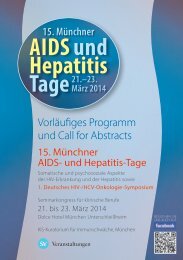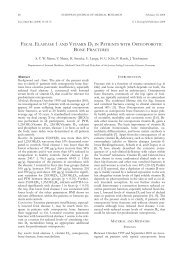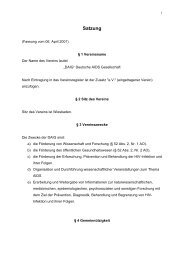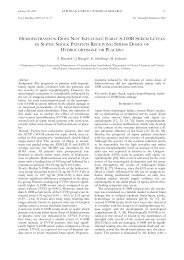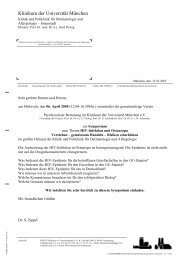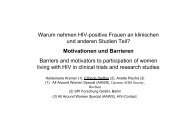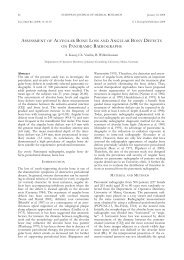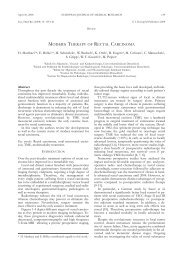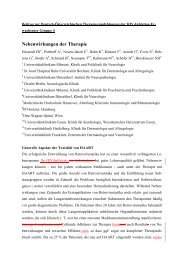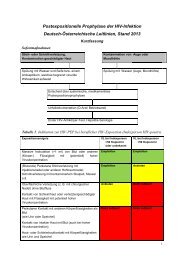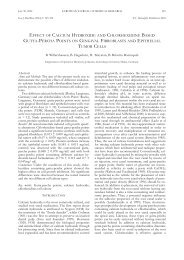atazanavir for treatment of hiv infection in clinical routine
atazanavir for treatment of hiv infection in clinical routine
atazanavir for treatment of hiv infection in clinical routine
Create successful ePaper yourself
Turn your PDF publications into a flip-book with our unique Google optimized e-Paper software.
January 28, 2005<br />
Abstract:<br />
Introduction: Atazanavir (ATV) is a novel protease <strong>in</strong>hibitor<br />
that has been recently <strong>in</strong>troduced <strong>in</strong>to therapy<br />
<strong>of</strong> HIV <strong><strong>in</strong>fection</strong>. Currently there is little data on ATV<br />
therapy from daily practice.<br />
Methods: In this retrospective study, we report on ATV<br />
efficacy and safety <strong>in</strong> cl<strong>in</strong>ical rout<strong>in</strong>e. Drug monitor<strong>in</strong>g<br />
was per<strong>for</strong>med consist<strong>in</strong>g <strong>of</strong> unscheduled s<strong>in</strong>gle measurements<br />
and a 4-hour-pr<strong>of</strong>ile. Trough concentration<br />
<strong>of</strong> >80 ng/ml and peak concentration <strong>of</strong> 2000-6000<br />
ng/ml were regarded as sufficient.<br />
Results: Between May 2003 and April 2004, ATV <strong>treatment</strong><br />
was started <strong>in</strong> 42 patients, mean observation<br />
time was 32 weeks (6-53). Mean age was 45.6 years,<br />
38% had prior AIDS, viral load was undetectable <strong>in</strong><br />
73%. Important side effects were m<strong>in</strong>or or moderate<br />
diarrhea (27%) and fatigue (15%). ATV was discont<strong>in</strong>ued<br />
<strong>in</strong> 10% due to side effects or malignant diseases.<br />
No significant <strong>in</strong>fluence on mean values <strong>of</strong> cholesterol,<br />
triglycerides, liver enzymes, CD4-cell-count, and<br />
HI-viral load was seen. Virologic failure occurred <strong>in</strong><br />
13% <strong>of</strong> patients, all <strong>of</strong> them were PI-experienced.<br />
Pharmacok<strong>in</strong>etic data are available <strong>for</strong> 32 patients, all<br />
patients had sufficient trough levels. 30% with unboosted<br />
ATV and 21% with boosted ATV had peak<br />
plasma concentrations below the level def<strong>in</strong>ed as sufficient.<br />
Mean trough levels, plasma pr<strong>of</strong>ile and AUC did<br />
not differ significantly between groups with nonboosted<br />
versus boosted ATV regimes but showed a<br />
wide <strong>in</strong>ter-patient variability.<br />
Conclusions: ATV <strong>treatment</strong> <strong>of</strong> HIV-<strong>in</strong>fected patients<br />
with or without a RTV booster was safe and effective<br />
<strong>in</strong> cl<strong>in</strong>ical rout<strong>in</strong>e. Drug levels were sufficient <strong>in</strong> the<br />
majority <strong>of</strong> cases. The variability <strong>of</strong> pharmacok<strong>in</strong>etic<br />
results <strong>in</strong> our sample supports therapeutic drug monitor<strong>in</strong>g<br />
<strong>in</strong> patients treated with ATV.<br />
Key words: HIV; HAART; Atazanavir; therapeutic drug<br />
monitor<strong>in</strong>g<br />
INTRODUCTION<br />
The <strong>in</strong>troduction <strong>of</strong> protease <strong>in</strong>hibitors (PI) <strong>in</strong> 1995<br />
was the start<strong>in</strong>g po<strong>in</strong>t <strong>of</strong> the era <strong>of</strong> highly active antiretroviral<br />
therapy <strong>of</strong> HIV <strong><strong>in</strong>fection</strong> (HAART). In the<br />
follow<strong>in</strong>g years, the widespread use <strong>of</strong> this substance<br />
group showed good virological and cl<strong>in</strong>ical efficacy,<br />
but also cumulative toxicity with<strong>in</strong> <strong>in</strong> the treated patient<br />
population [5, 10]. The HIV-associated lipodystrophy<br />
syndrome (LDS) is a frequent complication <strong>of</strong><br />
EUROPEAN JOURNAL OF MEDICAL RESEARCH 7<br />
Eur J Med Res (2005) 10: 7-10 © I. Holzapfel Publishers 2005<br />
ATAZANAVIR FOR TREATMENT OF HIV INFECTION IN CLINICAL ROUTINE:<br />
EFFICACY, PHARMACOKINETICS AND SAFETY<br />
T. Feldt 1, M. Oette 1, A. Kroidl 1, K. Göbels 1, R. Leidel 1, A. Sagir 1, D. Kuschak 2, D. Häuss<strong>in</strong>ger 1<br />
1 Cl<strong>in</strong>ic <strong>for</strong> Gastroenterology, Hepatology. and Infectious Diseases, University Cl<strong>in</strong>ic <strong>of</strong> Düsseldorf, Germany<br />
2 Medical Laboratories, Düsseldorf, Germany<br />
HAART and occurs <strong>in</strong> a substantial proportion <strong>of</strong> patients<br />
receiv<strong>in</strong>g a protease <strong>in</strong>hibitor [5]. It consists <strong>of</strong><br />
peripheral lipoatrophy, central fat accumulation along<br />
with hyperlipidaemia and <strong>in</strong>sul<strong>in</strong> resistance. It has<br />
been associated with an <strong>in</strong>crease <strong>in</strong> the risk <strong>for</strong> cardiovascular<br />
disease [3, 6]. Atazanavir is a novel azapeptide<br />
protease <strong>in</strong>hibitor that promises advantages <strong>in</strong> terms<br />
<strong>of</strong> side effects and convenience. It is a compound with<br />
a once daily adm<strong>in</strong>istration and favourable resistance<br />
pr<strong>of</strong>ile, cl<strong>in</strong>ical efficacy, and little effect on serum lipid<br />
concentrations [7]. It is hoped that this improvement<br />
<strong>in</strong> the lipid pr<strong>of</strong>ile translates to less lipodystrophy, although<br />
there is only little data to support this theory<br />
[8].<br />
Atazanavir can either be adm<strong>in</strong>istered 400mg once<br />
daily or 300mg with a ritonavir-booster <strong>of</strong> 100mg. The<br />
latter is the only approved dosage <strong>for</strong> Europe. ATV<br />
Plasma concentrations have been shown to exceed the<br />
IC50 value <strong>of</strong> wild type virus beyond the 24 hours<br />
dos<strong>in</strong>g <strong>in</strong>terval [2], although higher plasma concentrations<br />
may be needed to overcome low-level drug resistance.<br />
Therapeutic drug monitor<strong>in</strong>g (TDM) is an <strong>in</strong>strument<br />
to <strong>in</strong>dividualize drug dosage currently under<br />
<strong>in</strong>vestigation <strong>in</strong> different cl<strong>in</strong>ical sett<strong>in</strong>gs [1, 4].<br />
The aim <strong>of</strong> the study was to summarize early experience<br />
<strong>of</strong> application <strong>of</strong> ATV <strong>in</strong>clud<strong>in</strong>g TDM <strong>in</strong> cl<strong>in</strong>ical<br />
rout<strong>in</strong>e.<br />
METHODS<br />
All patients who started Atazanavir from May 2003<br />
until April 2004 <strong>in</strong> the outpatient unit <strong>of</strong> the Düsseldorf<br />
University Cl<strong>in</strong>ic were <strong>in</strong>cluded <strong>in</strong>to a retrospective<br />
analysis. Rout<strong>in</strong>e laboratory exam<strong>in</strong>ations <strong>in</strong>clud<strong>in</strong>g<br />
chemistry, CD4-cell count, and HIV RNA levels<br />
were determ<strong>in</strong>ed, cl<strong>in</strong>ical data were collected by chart<br />
review. Basel<strong>in</strong>e characteristics, adverse events, toxicities<br />
and laboratory results as well as co-medication<br />
were documented. Measurement <strong>of</strong> ATV and ritonavir<br />
plasma levels was conducted as an unscheduled blood<br />
sample and, subsequently, a scheduled four-hour pharmacok<strong>in</strong>etic<br />
pr<strong>of</strong>ile. The pharmacok<strong>in</strong>etic pr<strong>of</strong>ile was<br />
per<strong>for</strong>med at least one month after start<strong>in</strong>g ATV. At 8<br />
a.m., after hav<strong>in</strong>g taken the usual medication the day<br />
be<strong>for</strong>e and fast<strong>in</strong>g overnight, five ml <strong>of</strong> plasma were<br />
drawn be<strong>for</strong>e and 1, 2, 3 and 4 hours after medication<br />
was adm<strong>in</strong>istered with the patient´s breakfast.<br />
ATV with a molecular weight <strong>of</strong> 801.94 g/mol, obta<strong>in</strong>ed<br />
as reference material <strong>in</strong> the sulfate-salt <strong>for</strong>m by
8 EUROPEAN JOURNAL OF MEDICAL RESEARCH<br />
January 28, 2005<br />
the manufacturer, Bristol-Myers Squibb, New Brunswick,<br />
NJ, USA. A 86093 from ABBOTT, Abbott Park,<br />
IL, USA, was used as <strong>in</strong>ternal standard. The determ<strong>in</strong>ation<br />
<strong>of</strong> ATV was done by gradient high per<strong>for</strong>mance<br />
liquid chromatography [9] with UV-detection at<br />
215 nm and additionally by a photo diode array detection<br />
(Spectra System 6000 LP) with Chromquest<br />
S<strong>of</strong>tware, all parts from Thermo Separation Products,<br />
San Jose, CA, USA. With the described technique<br />
Atazanavir absorption maxima at 210, 250 and 279 nm<br />
were checked <strong>for</strong> peak purity. There<strong>for</strong>e, any <strong>in</strong>terference<br />
with nonnucleoside reverse transcriptase <strong>in</strong>hibitors<br />
or the other protease <strong>in</strong>hibitors, which could<br />
be determ<strong>in</strong>ed simultaneously, was excluded. L<strong>in</strong>earity<br />
<strong>of</strong> detection was given <strong>for</strong> a m<strong>in</strong>imum <strong>of</strong> 100 to a<br />
maximum <strong>of</strong> 7000 ng/ml. ATV target levels were def<strong>in</strong>ed<br />
as >80 ng/ml <strong>for</strong> trough level and 2000-6000<br />
ng/ml <strong>for</strong> peak level concentrations.<br />
Data are presented as mean ± standard deviation<br />
unless <strong>in</strong>dicated otherwise. Comparison between subgroups<br />
or different time po<strong>in</strong>ts was per<strong>for</strong>med us<strong>in</strong>g<br />
paired or non paired t-test. Correlations were analysed<br />
by us<strong>in</strong>g the Pearson correlation coefficient. P-values<br />
less than 0.05 were considered as statistically significant.<br />
A correction <strong>for</strong> multiple test<strong>in</strong>g was not per<strong>for</strong>med.<br />
RESULTS<br />
In the <strong>in</strong>vestigational period from May 2003 to April<br />
2004, ATV <strong>treatment</strong> was started <strong>in</strong> 42 patients. One<br />
patient was lost to follow up; the mean observation<br />
time was 32 (6-53) weeks; basel<strong>in</strong>e characteristics are<br />
presented <strong>in</strong> Table 1.<br />
Chronic hepatitis C and hepatitis B virus <strong><strong>in</strong>fection</strong><br />
were each present <strong>in</strong> one patient. Reasons <strong>for</strong> switch<strong>in</strong>g<br />
to ATV were hyperlipidaemia (21 patients; 50%),<br />
lipodystrophy (13 patients; 31%), the wish <strong>for</strong> a more<br />
convenient therapy regime with less pills (12 patients;<br />
29 %), diarrhea (9 patients; 21%) or other side effects<br />
under previous <strong>treatment</strong> (12 patients; 29%), and virological<br />
failure <strong>of</strong> HAART (4 patients; 10%), respectively<br />
(multiple options <strong>in</strong>cluded). One patient received<br />
ATV as <strong>in</strong>itial therapy.<br />
Table 2. Laboratory parameters, mean ±SD, *=p
January 28, 2005 EUROPEAN JOURNAL OF MEDICAL RESEARCH<br />
9<br />
Table 3. Atazanavir and ritonavir plasma concentrations.<br />
ATV 300mg/<br />
RTV 100mg<br />
rameters except the discussed elevations <strong>of</strong> bilirub<strong>in</strong><br />
levels was noted. Furthermore, mean HIV RNA plasma<br />
levels and CD4-cell count did not change significantly<br />
dur<strong>in</strong>g ATV <strong>treatment</strong>. Of the 30 patients with<br />
undetectable HIV plasma levels (10fold<br />
<strong>in</strong> peak levels). In three patients who were<br />
changed from non-boosted to boosted ATV, the AUC<br />
<strong>in</strong>creased from 4770 ± 1313 to 6824 ± 3902 ng*h/ml.<br />
Sixteen patients received Ten<strong>of</strong>ovir (TDF), <strong>of</strong><br />
which eight patients had a once daily therapy regime<br />
(six <strong>in</strong> comb<strong>in</strong>ation with Didanos<strong>in</strong>e and two <strong>in</strong> comb<strong>in</strong>ation<br />
with Lamivud<strong>in</strong>e). Ten<strong>of</strong>ovir co-medication<br />
did not significantly decrease ATV plasma concentrations<br />
<strong>in</strong> boosted regimens, as compared <strong>in</strong> patients<br />
tak<strong>in</strong>g TDF vs. patients not tak<strong>in</strong>g TDF (AUC<br />
7788±4268 vs. 8272 ± 2904 ng*h/ml).<br />
DISCUSSION<br />
Atazanavir is a new protease <strong>in</strong>hibitor that has been<br />
recently <strong>in</strong>troduced <strong>in</strong>to cl<strong>in</strong>ical use. The aim <strong>of</strong> the<br />
study was to <strong>in</strong>vestigate the pharmacok<strong>in</strong>etics and<br />
safety <strong>of</strong> this compound after one year <strong>of</strong> rout<strong>in</strong>e application.<br />
The majority <strong>of</strong> our patients were switched<br />
to ATV from previous PI or NNRTI. The most important<br />
reasons <strong>for</strong> switch<strong>in</strong>g to ATV were side effects<br />
<strong>of</strong> previous HAART and the wish <strong>for</strong> more conve-
10 EUROPEAN JOURNAL OF MEDICAL RESEARCH<br />
January 28, 2005<br />
nient adm<strong>in</strong>istration. ATV was generally well tolerated,<br />
although a mild <strong>in</strong>crease <strong>in</strong> bilirub<strong>in</strong> was observed <strong>in</strong><br />
almost all patients. The latter is rarely <strong>of</strong> cl<strong>in</strong>ical significance<br />
and led to discont<strong>in</strong>uation <strong>of</strong> ATV <strong>in</strong> only one<br />
patient without signs <strong>of</strong> liver toxicity. Other reasons<br />
<strong>for</strong> discont<strong>in</strong>uation were AIDS-def<strong>in</strong><strong>in</strong>g events and<br />
non-HIV-related diseases that were not typical ATVassociated<br />
side effects. Apart from this, laboratory<br />
measurements revealed no further toxicity <strong>of</strong> relevance.<br />
Thus, ATV seems to be a safe PI with a convenient<br />
dos<strong>in</strong>g frequency. However, <strong>in</strong> contrast to previous<br />
results, we found no relevant change <strong>of</strong> cholesterol,<br />
HDL, LDL or triglycerides after switch<strong>in</strong>g to<br />
ATV. The significance <strong>of</strong> this f<strong>in</strong>d<strong>in</strong>g is limited by<br />
basel<strong>in</strong>e lipid concentrations which were only marg<strong>in</strong>ally<br />
elevated and the lack <strong>of</strong> fast<strong>in</strong>g state documentation<br />
at sampl<strong>in</strong>g time.<br />
ATV <strong>treatment</strong> was immunologically and virologically<br />
effective <strong>in</strong> the majority <strong>of</strong> patients. In particular,<br />
6 <strong>of</strong> 7 patients with detectable viral load at basel<strong>in</strong>e and<br />
a follow-up period <strong>of</strong> at least 12 weeks achieved undetectable<br />
viral load with ATV-conta<strong>in</strong><strong>in</strong>g <strong>treatment</strong>.<br />
However, the risk <strong>of</strong> virological failure after switch<strong>in</strong>g<br />
to ATV even with undetectable HIV RNA plasma levels<br />
must be considered, particularly <strong>in</strong> protease <strong>in</strong>hibitor<br />
experienced patients. The percentage <strong>of</strong> virological<br />
failure <strong>in</strong> patients with undetectable HIV RNA<br />
at the time <strong>of</strong> switch<strong>in</strong>g to ATV was 13 %, both <strong>in</strong> patients<br />
receiv<strong>in</strong>g boosted and unboosted ATV.<br />
ATV plasma concentrations <strong>in</strong>dicate sufficient bioavailability<br />
<strong>of</strong> ATV alone and ATV boosted with Ritonavir<br />
100mg once daily. ATV plasma levels showed a<br />
wide <strong>in</strong>ter-patient variation, but exceeded the target<br />
trough concentrations <strong>in</strong> all patients. 30 % <strong>of</strong> cases<br />
with non-boosted and 21 % <strong>of</strong> patients with boosted<br />
ATV had peak concentrations below the target without<br />
association to virological response. The latter f<strong>in</strong>d<strong>in</strong>gs<br />
are arguments <strong>for</strong> perfom<strong>in</strong>g therapeutic drug<br />
monitor<strong>in</strong>g <strong>in</strong> cl<strong>in</strong>ical rout<strong>in</strong>e. ATV drug concentration<br />
can be safely <strong>in</strong>creased with co-adm<strong>in</strong>istration <strong>of</strong><br />
100mg Ritonavir once daily, few patients seem to experience<br />
additive side effects. In contrast to previous<br />
data [11], co-medication with Ten<strong>of</strong>ovir was not<br />
associated with decreased ATV plasma levels or virological<br />
failure. Thus, Ten<strong>of</strong>ovir may be a convenient<br />
comb<strong>in</strong>ation partner <strong>in</strong> an ATV-conta<strong>in</strong><strong>in</strong>g once-daily<br />
regimen. An unresolved issue is the determ<strong>in</strong>ation <strong>of</strong><br />
validated target concentrations <strong>for</strong> trough and peak<br />
levels.<br />
Our f<strong>in</strong>d<strong>in</strong>gs may be limited by the retrospective<br />
design <strong>of</strong> the study and the size <strong>of</strong> the observed cohort.<br />
However, they consist <strong>of</strong> unselected data possibly<br />
resembl<strong>in</strong>g daily practice <strong>of</strong> HIV-therapy. Thus,<br />
our conclusion is that ATV <strong>treatment</strong> <strong>in</strong> cl<strong>in</strong>ical rout<strong>in</strong>e<br />
shows good safety as well as tolerability. Moreover,<br />
ATV <strong>treatment</strong> with<strong>in</strong> different HAART comb<strong>in</strong>ations<br />
is virologically and immunologically effective.<br />
The pharmacok<strong>in</strong>etic data suggest sufficient bioavailability<br />
<strong>of</strong> ATV <strong>in</strong> more than 70% <strong>of</strong> patients. In spite<br />
<strong>of</strong> a clear association <strong>of</strong> therapeutic drug monitor<strong>in</strong>g<br />
with virological and toxic effects <strong>of</strong> protease <strong>in</strong>hibitors,<br />
there is significant <strong>in</strong>ter-patient variability <strong>of</strong><br />
pharmacok<strong>in</strong>etic results <strong>in</strong> literature [1]. As this is also<br />
the case <strong>in</strong> our study, the prognostic value <strong>of</strong> ATV-<br />
concentration measurement rema<strong>in</strong>s to be determ<strong>in</strong>ed.<br />
However, our data <strong>in</strong>dicate subgroups <strong>of</strong> patients that<br />
might benefit from therapeutic drug monitor<strong>in</strong>g. We<br />
recommend ATV plasma concentration measurement<br />
particularly <strong>in</strong> PI-experienced patients, <strong>in</strong> regimens<br />
with non-boosted ATV, and <strong>in</strong> patients receiv<strong>in</strong>g other<br />
medication with potential drug <strong>in</strong>teractions. This strategy<br />
may help to optimize the pharmacok<strong>in</strong>etic pr<strong>of</strong>ile<br />
and thus therapeutic efficacy.<br />
REFERENCES:<br />
1. Aarnoutse RE, Schapiro JM, Boucher CA, Hekster YA,<br />
Burger DM (2003). Therapeutic drug monitor<strong>in</strong>g: an aid<br />
to optimis<strong>in</strong>g response to antiretroviral drugs? Drugs<br />
63:741-753<br />
2. Agarwala S (2003). Characterization <strong>of</strong> the steady state<br />
pharmacok<strong>in</strong>etic pr<strong>of</strong>ile <strong>of</strong> <strong>atazanavir</strong> beyond the 24h<br />
dos<strong>in</strong>g <strong>in</strong>terval. 2 nd IAS, Paris13.16.07.03. Abstract 845<br />
3. Barbaro, G (2003). HIV <strong><strong>in</strong>fection</strong>, highly active antiretroviral<br />
therapy and the cardiovascular system. Cardiovasc<br />
Res 60:87-95<br />
4. Burger DM, Hugen PW, Aarnoutse RE, et al (2003).<br />
Treatment failure <strong>of</strong> nelf<strong>in</strong>avir-conta<strong>in</strong><strong>in</strong>g triple therapy<br />
can largely be expla<strong>in</strong>ed by low nelf<strong>in</strong>avir plasma concentrations.<br />
Ther Drug Monit 25:73-80<br />
5. Carr A, Samaras K, Thorisdottir A, Kaufmann GR,<br />
Chisholm DJ, Cooper DA (1999). Diagnosis, prediction,<br />
and natural course <strong>of</strong> HIV-1 protease-<strong>in</strong>hibitor-associated<br />
lipodystrophy, hyperlipidaemia, and diabetes mellitus: a<br />
cohort study. Lancet 353:2093-2099<br />
6. Carr A (2003). Cardiovascular risk factors <strong>in</strong> HIV-<strong>in</strong>fected<br />
patients. J Acquir Immune Defic Syndr 34(Suppl 1):<br />
S73-S78.<br />
7. Goldsmith DR, Perry CM (2003). Atazanavir. Drugs<br />
63:1679-1693<br />
8. Haerter G, Manfras BJ, Mueller M, Kern P, Tre<strong>in</strong> A<br />
(2004). Regression <strong>of</strong> lipodystrophy <strong>in</strong> HIV-<strong>in</strong>fected patients<br />
under therapy with the new protease <strong>in</strong>hibitor<br />
<strong>atazanavir</strong>. AIDS 18:952-955<br />
9. Kuschak D, Mauss S, Schmutz G, Gantke B (2001). Simultaneous<br />
determ<strong>in</strong>ation <strong>of</strong> the new HIV protease <strong>in</strong>hibitor<br />
Lop<strong>in</strong>avir (ABT 378) and <strong>of</strong> Ind<strong>in</strong>avir, Amprenavir,<br />
Saqu<strong>in</strong>avir, Ritonavir (ABT 538) and Nelf<strong>in</strong>avir <strong>in</strong><br />
human plasma by gradient HPLC. Cl<strong>in</strong> Lab 47:471-477<br />
10. Palella FJ Jr, Delaney KM, Moorman AC, et al (1998).<br />
Decl<strong>in</strong><strong>in</strong>g morbidity and mortality among patients with<br />
advanced human immunodeficiency virus <strong><strong>in</strong>fection</strong>. HIV<br />
Outpatient Study Investigators. New Engl J Med 338:853-<br />
860<br />
11. Taburet A-M, Piketty C, Chazallon C, et al (2004). Interactions<br />
between Atazanavir-Ritonavir and Ten<strong>of</strong>ovir <strong>in</strong><br />
heavily pretreated human immunodeficiency virus-<strong>in</strong>fected<br />
patients. Antimicrob Agents Chemother 48:2091-2096<br />
Received: September 7, 2004 / Accepted: December 22, 2004<br />
Address <strong>for</strong> correspondence:<br />
Dr. Mark Oette<br />
Cl<strong>in</strong>ic <strong>for</strong> Gastroenterology, Hepatology, and<br />
Infectious Diseases<br />
University Cl<strong>in</strong>ic <strong>of</strong> Düsseldorf<br />
Moorenstr. 5<br />
D-40225 Düsseldorf, Germany<br />
Tel. +49-211/8118942<br />
Fax +49-211/8116294<br />
e-mail oettem@med.uni-duesseldorf.de



